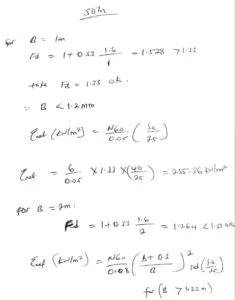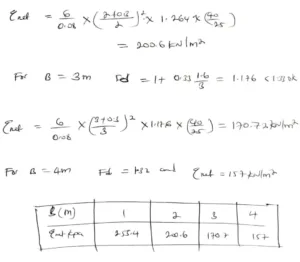Question
The average N60 blow count =6 in the effective zone for a footing located at D = 1.6m (blow count in range from 1-to 4m depth).
What is the allowable bearing capacity for a 40mm settlement? present data as a table of qa versus B.
Solution to The average N60 blow…


What causes differential settlement?
Differential settlement is caused by a number of factors, including:
- Type of soil: Differential settlement is most commonly caused by differences in the type of soil beneath a foundation. For example, sand will settle more than clay.
- Moisture in the soil: Soil that is too dry or too wet will settle more than soil that is at a moderate moisture level.
- Weight on the soil: A foundation that is too heavy or has too much weight on it will settle more than a lighter foundation.
- Size and depth: Size and depth of the foundation can also affect differential settlement. For example, a shallower foundation will settle more than a deeper foundation and a larger foundation will settle more than a smaller foundation.
- Shape of the foundation: A foundation that is not level or has an irregular shape will settle more than a level foundation with a regular shape.
What causes soil settlement?
Geotechnical settlement is typically the result of loading
(from a building or vehicles moving along on a road, for example) exceeding the ground’s bearing capacity.
Due to site ground pressures, pore water pressure increases and then dissipates,
causing consolidation settlement, where the soil beneath the structure moves vertically and horizontally.
Weak and poorly compacted soils are particularly vulnerable.
Soil settlement can be caused by other factors too,
such as changes in soil moisture content, for example, saturated cohesive soils may soften or drier cohesive soils may shrink.
Deep excavations and tunneling, plus the collapse of naturally occurring voids or abandoned mine workings,
are also key factors in causing different types of settlement.
Settlement occurs immediately after a load is applied or take years, depending on the underlying soil conditions
Geotechnical engineers often carry out settlement analysis prior to construction to analyze the ground conditions
and recommend foundation solutions for preventing settlement in the future.




